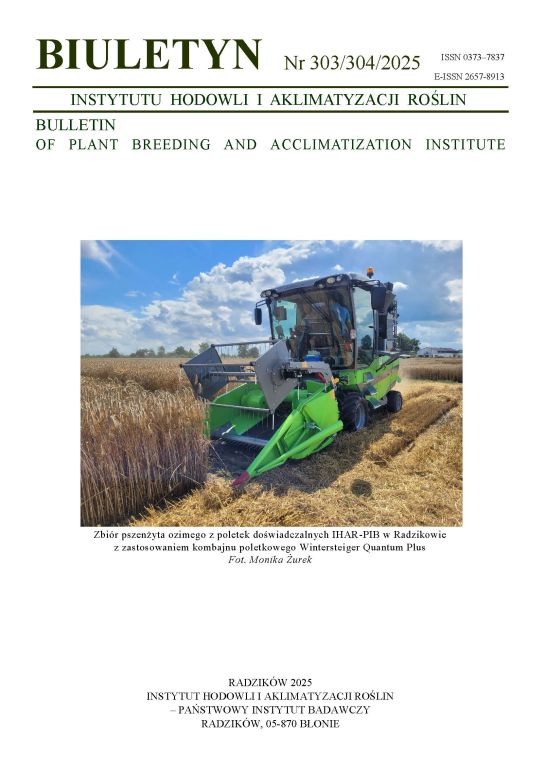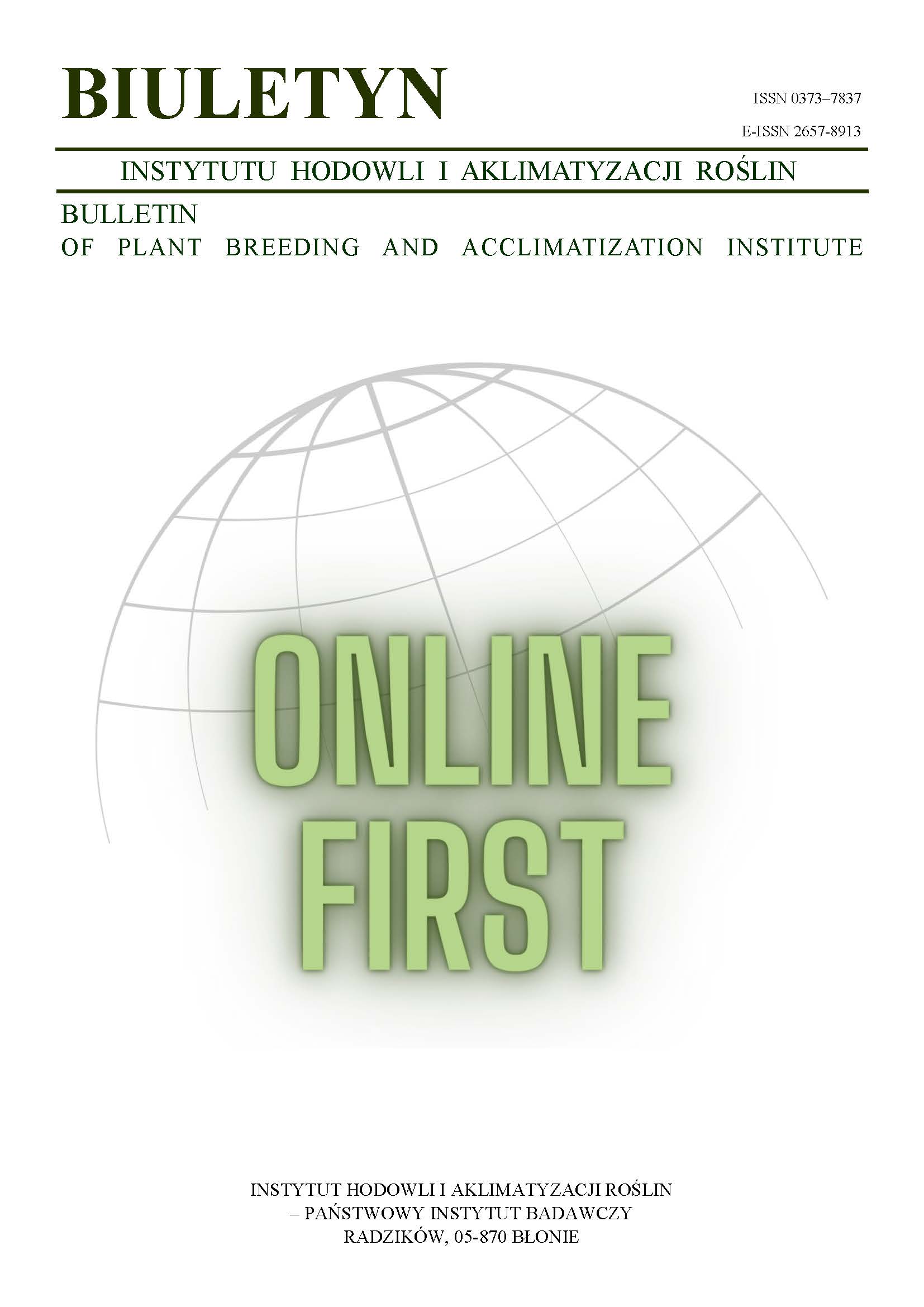Influence of seed potato spring dressing on occurrence of black scurf and yield quantity and quality
Jerzy Osowski
j.osowski@ihar.edu.plZakład Nasiennictwa i Ochrony Ziemniaka w Boninie, Instytut Hodowli i Aklimatyzacji Roślin w Radzikowie (Poland)
Abstract
The effectiveness of the chemical control of black scurf (Rhizoctonia solani) development on the potato plants and tubers was estimated in field trials. Potato seed tubers were dressed with the chemicals: Vitavax 200 FS and Monceren 250 FS 2–3 days before planting. After harvest, 10 kg samples of tubers (from each plot) were washed and visually assessed for black scurf and crop fractions. The results showed that all the tested chemicals were efficient in the black scurf control in the years 1999–2002 (statistically significant). The use of dressing caused yield increase of large tubers from 26.5% to 48.5% for the variety Bryza and from 0.5 to 12.0% for the variety Rywal.
Keywords:
Rhizoctonia solani, potato, seed dressingReferences
Gudmestad Neil C. 2002. Rhizoctonia canker of potato www.ndsu.nodak.edu./instruct/gudmesta/lateblight/ rhizoctext.html.
Google Scholar
Häni F., Popow G., Reinhard A. 1998. Ochrona roślin rolniczych w uprawie integrowanej. PWRiL, Warszawa: 130 — 131.
Google Scholar
Kochman J., Węgorek W. 1997. Ochrona roślin. Plantpress, Kraków: 525 — 526.
Google Scholar
Lumkes A., Vervet H. 1979. Bericht PAGV — Lelystadt, Intern. Verlag, Nr 81.
Google Scholar
Lutomirska B., Szutkowska M. 2000. Poradnik producentów ziemniaka sezon 2000/2001. IHAR Oddz. Jadwisin: 63 — 77.
Google Scholar
Osowski J. 2002. Wpływ zaprawiania na zdrowotność bulw ziemniaka. Biul. IHAR 223/224: 369 — 373.
Google Scholar
Platt H. W., MacLeanV. M. 1997. Efficacy of chemical control products for control of soil-borne potato diseases caused by soil-borne fungal pathogens in 1995. Tests of agrochemicals and cultivars. 1997, No. 18, 16–17, Annals of Applied Biology 130, Supplement: 1 ref.
Google Scholar
Rahkonen A., Pietilä L., Kuisma P. 1999. Controlling Rhizoctonia solani by seed dressing in Finland. 14th Triennial Conference of the European Association for Potato Research Abstracts of Conference Papers, Posters and Demonstrations May, 2–7, 1999, Sorrento, Italy: 178 — 179.
Google Scholar
Wainwright A., Nicholson T., Mann D. H. 1996. Control of silver scurf and black scurf in potatoes with a pencycuron/tolyleluanid seed tuber treatment. Brighton Crop Protection Conference Pests & Diseases: 275 — 300.
Google Scholar
Wróbel S., Erlichowski T. 1998. Możliwości zastosowania zaprawy fungicydowo-insektycydowej Prestige 290 FS w uprawie ziemniaka. Mat. Konf. „Ochrona Ziemniaka” 21–22 kwietnia, Kołobrzeg IHAR Oddz. Bonin: 29 — 32.
Google Scholar
Zarzyńska K., Gruczek T. 2000. Poradnik producentów ziemniaka sezon 2000/2001. IHAR Oddz. Jadwisin: 50 — 52.
Google Scholar
Zarzyńska K., Szutkowska M. 2002. Specyficzne elementy technologii uprawy na przetwory spożywcze W: Produkcja i rynek ziemniaków jadalnych. Pod red. J. Chotkowskiego, IHAR, Bonin: 121 — 124.
Google Scholar
Authors
Jerzy Osowskij.osowski@ihar.edu.pl
Zakład Nasiennictwa i Ochrony Ziemniaka w Boninie, Instytut Hodowli i Aklimatyzacji Roślin w Radzikowie Poland
Statistics
Abstract views: 114PDF downloads: 21
License
Copyright (c) 2004 Jerzy Osowski

This work is licensed under a Creative Commons Attribution-ShareAlike 4.0 International License.
Upon submitting the article, the Authors grant the Publisher a non-exclusive and free license to use the article for an indefinite period of time throughout the world in the following fields of use:
- Production and reproduction of copies of the article using a specific technique, including printing and digital technology.
- Placing on the market, lending or renting the original or copies of the article.
- Public performance, exhibition, display, reproduction, broadcasting and re-broadcasting, as well as making the article publicly available in such a way that everyone can access it at a place and time of their choice.
- Including the article in a collective work.
- Uploading an article in electronic form to electronic platforms or otherwise introducing an article in electronic form to the Internet or other network.
- Dissemination of the article in electronic form on the Internet or other network, in collective work as well as independently.
- Making the article available in an electronic version in such a way that everyone can access it at a place and time of their choice, in particular via the Internet.
Authors by sending a request for publication:
- They consent to the publication of the article in the journal,
- They agree to give the publication a DOI (Digital Object Identifier),
- They undertake to comply with the publishing house's code of ethics in accordance with the guidelines of the Committee on Publication Ethics (COPE), (http://ihar.edu.pl/biblioteka_i_wydawnictwa.php),
- They consent to the articles being made available in electronic form under the CC BY-SA 4.0 license, in open access,
- They agree to send article metadata to commercial and non-commercial journal indexing databases.
Most read articles by the same author(s)
- Jerzy Osowski, Janusz Urbanowicz , Silver scab (Helminthosporium solani) – symptoms and control , Bulletin of Plant Breeding and Acclimatization Institute: No. 294 (2021): Regular issue
- Jerzy Osowski, Diversity of black scurf symptoms caused by Rhizoctonia solani on potato tubers depending on cultivar and meteorological conditions , Bulletin of Plant Breeding and Acclimatization Institute: No. 274 (2014): Regular issue
- Jerzy Osowski, Janusz Urbanowicz, The influence of microstarters B and K on the volume and quality of potato tubers , Bulletin of Plant Breeding and Acclimatization Institute: No. 292 (2020): Special issue
- Jerzy Osowski, Resistance of potato varieties as an element of integrated pest management , Bulletin of Plant Breeding and Acclimatization Institute: No. 266 (2012): Regular issue
- Edward Bernat, Jerzy Osowski, The use of decision support system NegFry to late blight control , Bulletin of Plant Breeding and Acclimatization Institute: No. 256 (2010): Regular issue
- Józefa Kapsa, Marek Mrówczyński, Tomasz Erlichowski, Hanna Gawińska-Urbanowicz, Konrad Matysek, Jerzy Osowski, Maria Pawińska, Janusz Urbanowicz, Sławomir Wróbel, Potato protection according to the principles of integrated pest management. Part II. Sustainable method of chemical potato protectio , Bulletin of Plant Breeding and Acclimatization Institute: No. 273 (2014): Regular issue
- Józefa Kapsa, Marek Mrówczyński, Tomasz Erlichowski, Hanna Gawińska-Urbanowicz, Konrad Matysek, Jerzy Osowski, Maria Pawińska, Janusz Urbanowicz, Sławomir Wróbel, Potato protection according to the principles of integrated pest management. Part I. Non-chemical methods of protection , Bulletin of Plant Breeding and Acclimatization Institute: No. 273 (2014): Regular issue
- Jerzy Osowski, Black dot (Colletotrichum coccodes) as a new threat to potato plantation , Bulletin of Plant Breeding and Acclimatization Institute: No. 251 (2009): Regular issue
- Jerzy Osowski, The rate of potato late blight development (Phytophthora infestans) in 2005–2007 depending on weather conditions and cultivar resistance , Bulletin of Plant Breeding and Acclimatization Institute: No. 255 (2010): Regular issue
- Jerzy Osowski, The effectiveness of some fungicides in reducing the mycelial growth of Alternaria solani and A. alternata under laboratory conditions , Bulletin of Plant Breeding and Acclimatization Institute: No. 243 (2007): Regular issue














